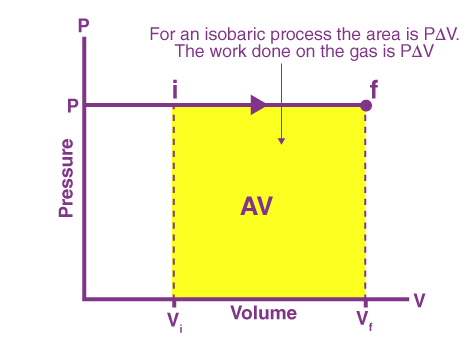What are the Thermodynamic Process? Types: Isobaric, Isochoric, Isothermal, Adiabatic
What is a thermodynamic process?
A thermodynamic process refers to the transformation or change that occurs in a system’s thermodynamic variables, such as temperature, pressure, volume, or internal energy. It describes how a system evolves from one equilibrium state to another. These processes involve interactions between the system and its surroundings, which can include heat transfer, work done, and changes in the system’s properties.
Thermodynamic processes are used to analyse and understand the behavior of systems in terms of energy exchanges and changes in state variables.
Isochoric process:
Isochoric process is a constant volume process, where no volume change occurs, sometimes this process is called a constant volume process. No volume change means no work done, work done is 0.


Isobaric process:
Isobaric process is a constant pressure process in thermodynamics, where ΔP = 0. But volume can change and work can be done. It is elaborate by the equation as follows:


Isothermal Process:
In an isothermal process, the temperature of the system remains constant throughout the process. This means that the system is in thermal equilibrium with its surroundings at all times. For an ideal gas, an isothermal process occurs when the gas expands or compresses while maintaining a constant temperature. The equation for an isothermal process is PV = constant, where P is pressure and V is volume.


Adiabatic process:
An adiabatic process is one in which there is no heat exchange between the system and its surroundings. This means that the process occurs without any heat transfer, either into or out of the system. In an adiabatic process, the change in internal energy of the system is solely due to work done on or by the system. For an ideal gas, an adiabatic process is characterized by PV = constant, where P is pressure, V is volume, and γ is the ratio of specific heats.


Note:
If you want to learn more about this topic, we suggest checking out our Combo package with the given link https://www.merchantnavydecoded.com/courses/c/ . It’s a great way to dive deeper into the subject through video explanations. This package covers all the important details and presents them in an easy-to-understand format. Watching the videos will help you grasp the topic better and make learning more enjoyable. So, we highly recommend giving our Combo package a try to enhance your knowledge on the subject.
Disclaimer :- The opinions expressed in this article belong solely to the author and may not necessarily reflect those of Merchant Navy Decoded. We cannot guarantee the accuracy of the information provided and disclaim any responsibility for it. Data and visuals used are sourced from publicly available information and may not be authenticated by any regulatory body. Reviews and comments appearing on our blogs represent the opinions of individuals and do not necessarily reflect the views of Merchant Navy Decoded. We are not responsible for any loss or damage resulting from reliance on these reviews or comments.
Reproduction, copying, sharing, or use of the article or images in any form is strictly prohibited without prior permission from both the author and Merchant Navy Decoded.



[…] food good on ships for a long time, refrigeration is required for maintaining low temperatures. Low temperature is required to save meat, fish, vegetables, and dry foods from rotting. In ships, many types of […]